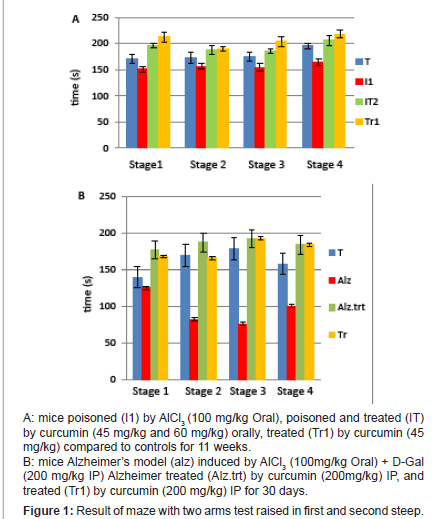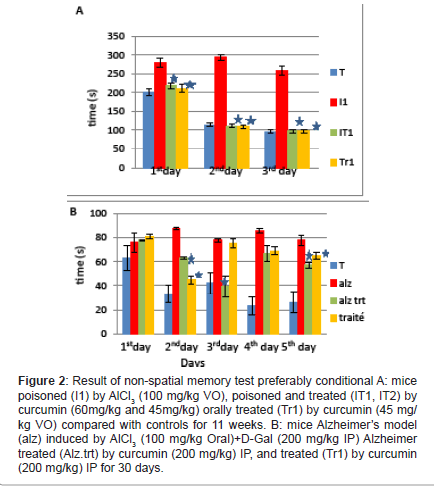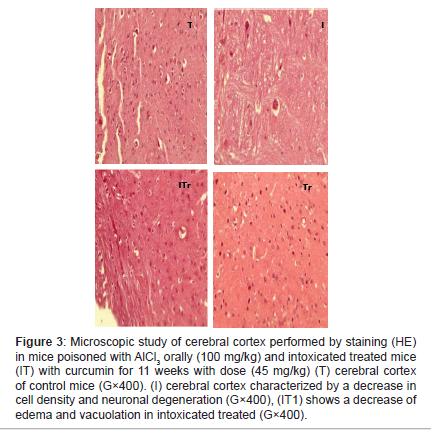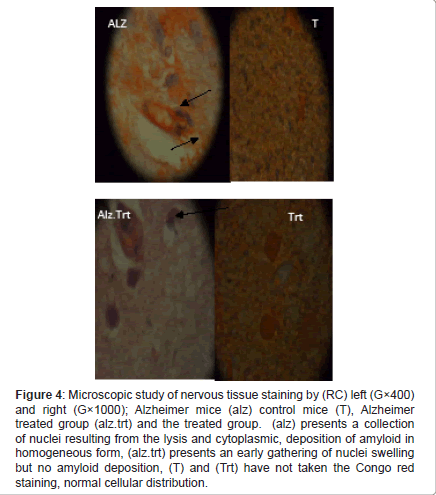Research Article Open Access
Neuroprotective Effect of Curcumin with a Fixator of Absorption against both Aluminium Neurotoxicity and Alzheimer's Disease (Experimental Studies in Mice)
Salima Douichene1*, Noureddine Djebli1, Moussa Ahmed2 and Kheira Zerrouki1
1Department of Biology, Faculty of SE & SNV, Laboratory of Micro Biology and Vegetal Biology (LMVB), Mostaganem University, Mostaganem, Algeria
2Department of Biology, Faculty of Sciences, Tiaret University, Tiaret, Algeria
- Corresponding Author:
- Salima Douichene
Department of Biology, Faculty of SE & SNV
Laboratory of Micro Biology and Vegetal Biology (LMVB)
Mostaganem University, Mostaganem, Algeria
E-mail: itadz@yahoo.fr
Received date: June 13, 2012; Accepted date: August 10, 2012; Published date: August 13, 2012
Citation: Douichene S, Djebli N, Ahmed M, Zerrouki K (2012) Neuroprotective Effect of Curcumin with a Fixator of Absorption against both Aluminium Neurotoxicity and Alzheimer’s Disease (Experimental Studies in Mice). J Alzheimers Dis Parkinsonism 2:107. doi:10.4172/2161-0460.1000107
Copyright: © 2012 Douichene S, et al. This is an open-access article distributed under the terms of the Creative Commons Attribution License, which permits unrestricted use, distribution, and reproduction in any medium, provided the original author and source are credited.
Visit for more related articles at Journal of Alzheimers Disease & Parkinsonism
Abstract
The versatility of Aluminium chemistry will ensure its burgeoning use in the future in all manner of applications. This very same chemistry will also ensure its increased biological availability in all biota including man. We do not know enough about the biological chemistry of a chronic and sub-acute exposure to Aluminium to be able to predict its impact on human health. Although the hypothesis of a link between Aluminium and Alzheimer's Disease (AD) has been supported by several epidemiological studies, there is much controversy regarding these findings and their interpretation. There is no doubt that the drugs discovered for neurodegenerative disease are far from ideal, and are not more than acetyl cholinesterase inhibitors, in fact alternative medicine could be moderate and protect nerves from neurotoxicity and AD. Curcumin is one of strong medicinal species that prove antioxidative stress effect against reactions cascade of neurofibrillary tangles. Our aims is to clarify the role of Curcumin with a fixative of absorption as a protective and therapeutic agent against neurodegenerative disorders and Alzheimer's disease induced by AlCl3 on the pyramidal cells in cerebral cortex and hippocampus of albino mice, by means of two experiences realized with a different exposition of albino mice; sub acute and chronic exposure with a different manner (PO and IP) on Curcumin with a fixative of absorption and AlCl3.
Keywords
Curcumin; Neurodegenerative disorders; Alzheimer’s disease; AlCl3
Introduction
Aluminum (Al) is a common metal in the environment and one of the most abundant in the terrestrial crust. Human exposure to Al has been increasing over the last few decade’s [1]. This element appears mainly in food products and in drinking water derived from both natural sources and treatment methods Oxidative injury has been suggested to contribute to neurodegenerative and metabolic disorders [2]. Epidemiological studies have indicated a link between Al in drinking water and AD and a variety of human and animal studies have implicated learning and memory deficit after Al exposure [3,4].
Drugs currently available on the market include different inhibitors of acetylcholine esterase and N-methyl D-aspartate (NMDA) receptor antagonist. These drugs improve the function of still intact neurons, but do not inhibit the ongoing degenerative process leading the neuronal cell death [5].
Curcumin is a biological active component of turmeric (curcuma longa) is used as a curry spice and herbal medicine for the treatment of inflammatory conditions, cancer, AIDS, and other diseases [6]. Results show that a low dose of curcumin significantly suppressed the inflammatory reactions, oxidative damage and plaque burden and decreased the amount of insoluble amyloid [7].
To assess a spectrum of learning and memory functions a battery of tests is needed. These tests are selected to assess behavior and memory. The present studies were undertaken to assess the neuroprotective effect of curcumin administrated with Al represented by behavior and memory tests, confirmed by the histological study of mice’s brains.
Materials and Methods
Chemicals
AlCl3+6H2O were purchased from Merck Chemical Co (Germany).
Curcumin and the other chemicals were purchased from Sigma- Aldrich Chemical Co.
Animals and treatment
Fifty five healthy adult mice weighting from 18-22 g were obtained from Pasteur institute Algeria. They were maintained at 24 ± 5°C with a 12 h light/dark cycle, and have been given a commercial pellet diet (ONAB Algeria) and fresh drinking water ad libitum.
The mice were randomly divided into four groups; each group containing seven mice (for each experience: neurotoxicity, Alzheimer’s model): control group, neurotoxicity and Alzheimer model, intoxicated/Alzheimer treated groups and the control treated groups. AlCl3 dissolved in distilled water administrated orally (100 mg/kg) for the intoxicated/Alzheimer’s model groups, and intoxicated/Alzheimer’s treated groups, with a D-Galactose IP (200 mg/kg) for the Alzheimer’s model given for 11 weeks; in parallel of curcumin administration (45 mg orally-200 mg/kg IP) respectively for the intoxicated treated group and Alzheimer disease animal model. The control treated groups received the same doses of curcumin (45-200 mg/kg).
Behavioral tests
Functional behavioral assessment is required as part of testing the nervous status (manifest determinations). These guidelines apply to animals in special tests, including those with locomotors activity, curiosity (holes test), anxiety/curiosity (maze on +), anxiety (black/ white room) and Persolt test.
The assessment of animal memory using different types of mazes has been used in neurosciences [8]. Several models have been proposed recently, mainly trying to evaluate accuracy of choice between the alternatives presented in the same day of the session, instead of looking for the accumulated learning through successive days of training.
The Morris water maze is widely used to study spatial memory and learning. Animals are placed in a pool of water that is colored opaque with powdered non-toxic tempera paint, where they must swim to a hidden escape platform.
Histological analysis
Mice from both studies were sacrificed with an overdose of Chloral.
After the step-through avoidance test, the brains of mice were removed right after sacrifices. Removed brains were then impressed in 10% neutral buffered formaldehyde for 24 hours. Serial coronal paraffin sections were cut at 4 μm thickness for hematoxylin and eosin (H&E) and Congo red staining.
Statistical analysis
The experimental results were reported as mean SEM. Statistical analysis was performed using SPSS Software. Analysis of variance (ANOVA) and LSD test were used to compare the experimental groups with the controls. One-way ANOVA p value using the post hoc Fischer’s LSD test. P-value<0.05 was considered signifiant.
Results and Discussion
Behavioral tests
Performance of mice in the step through passive avoidance training and testing show a remarkable difference between the intoxicated treated/Alzheimer treated and the intoxicated/Alzheimer groups; the test of maze plus was assessed by the time spending in a covered arm squares noted as score per time of 20 mn, 5 mn each phases showed high activity for the intoxicated treated comparatively with the intoxicated group (Figure 1).
Memory tests
When non-spatial memory test preferably conditional the results obtained during the three experimental tests show that mice intoxicated take much longer to reach the food in the arm lit unlike control mice, treated intoxicated and that put a very short time to get informed on the arm (Figure 2).
Histological studies
H&E staining shows that there are typical neuropathological changes in the hippocampus of intoxicated/Alzheimer’s model. In the control groups the neurons were full and arranged tightly, the nuclei were light stained. By comparison in the model group mice the cytoplasm of neuron were shrunken, the nuclei were side moved and dark stained, neurofibrillary degeneration and neurons loss were observed in hippocampus. Curcumin administration shows moderated neuropathological changes. The neurons recovered their characteristic shape, with prolonged neurofibrillary tangles (Figure 3). Congo red staining shows the beginning of injuries induced by Aluminium, characterized by assembling of nuclei resulting from cytoplasm lysis, and a slowly reaction of neurodegenerative mechanism for the Alzheimer treated model. The control cell wasn’t stained with the Congo red (Figure 4).
Discussion
In the present study, the effects of Al exposure were investigated to describe the associated behavioral (Figures 1 and 2) and brain modifications. Neurodegenerative disease is characterized by progressive pathological changes in the brain (Figures 3 and 4) that translate into clinical signs of decline in cognitive abilities (memory), functional abilities, mood, behavior, and finally physical changes. The pathological changes in the Alzheimer's brain include deterioration and loss of neurons (nerve cells) leading to brain atrophy [8].
Dietary antioxidants cooperate with the body enzymes to protect the brain from free radical damage [9]. Curcumin (of curcuma longa) is used to improve mental concentration and memory capabilities. It has free radical scavenging and lipid peroxidation activities [10,11]. Also it is a potent antioxidant with low or no side effects, it increases antioxidant enzymes, hypoglycemic, antibacterial and antifungal properties [12,13]. The antioxidant activity of coriander could protect liver from oxidative damage [14] and from lead induced testis oxidative damage.
In this investigation the effect of curcumin with over load of aluminum chloride to mice lead to reduction of neurotoxicity and Alzheimer's disease appeared as shrunken decreasing of pyramidal cells, reduced effect of decreasing number of the pyramidal cells. These brain moderation changes induced by curcumin against aluminum chloride administration were due to reducing oxidative damage which contribute to disease pathogenesis and were in accordance with the aim of this study which is to prove the protective effect of curcumin against aluminium neurotoxicity [15], and also Alzheimer’s disease by means of curcumin administration with Aluminium chloride [16].
A: mice poisoned (I1) by AlCl3 (100 mg/kg Oral), poisoned and treated (IT) by curcumin (45 mg/kg and 60 mg/kg) orally, treated (Tr1) by curcumin (45 mg/kg) compared to controls for 11 weeks.
B: mice Alzheimer’s model (alz) induced by AlCl3 (100mg/kg Oral) + D-Gal (200 mg/kg IP) Alzheimer treated (Alz.trt) by curcumin (200mg/kg) IP, and treated (Tr1) by curcumin (200 mg/kg) IP for 30 days.
Figure 1: Result of maze with two arms test raised in first and second steep.
Figure 2: Result of non-spatial memory test preferably conditional A: mice poisoned (I1) by AlCl3 (100 mg/kg VO), poisoned and treated (IT1, IT2) by curcumin (60mg/kg and 45mg/kg) orally treated (Tr1) by curcumin (45 mg/ kg VO) compared with controls for 11 weeks.
B: mice AlzheimerâÂ?Â?s model (alz) induced by AlCl3 (100 mg/kg Oral)+D-Gal (200 mg/kg IP) Alzheimer treated (Alz.trt) by curcumin (200 mg/kg) IP, and treated (Tr1) by curcumin (200 mg/kg) IP for 30 days.
Mice were poisoned with Aluminium chloride (AlCl3) orally at 100 mg/kg/day in drinking water, another group poisoned with the same manner but treated with curcumin orally (45 mg/kg/day) for 11weeks. The animals of the control group received drinking water only during this period, and the control treated were received curcumin in distilled water (45 mg/kg). Results showed that curcumin moderated the Al effect on anxiety/curiosity of treated intoxicated animals (Figure 1). The same results were shown for the subchronic exposure to AlCl3 in mice Alzheimer’s model increase anxiety in opposite of the results obtained for the Alzheimer treated group.
Based on these results, it seems likely that enhanced in exploratory behavior in treated poisoned mice during the whole board test and locomotor activity may reflect the less anxiety response of an animal to an unfamiliar environment. The test was based on the adversive properties of the open field and in which antioxidant treatment -induced ease of exploratory activity is compared between treated poisoned and poisoned groups. This model permits simple and quick evaluation of the anxious behavior and its modification by pharmacological agents. In our present study forced swimming test showed a significantly increased immobility time of Al-treated mice. This test is a common behavioral test for assessing depression in which animals have given up the hope of escape and depression remains controversial [17], drugs with antioxidant activity reduce the time during which the animals remain immobile [18]. These observations were important for the evaluation of the cognitive tests in since impaired physiological functions or changed motor performance may conflict with learning and memory tests [19]. Most learning paradigms that require configural associations require a fully functioning hippocampus; however learning paradigms that can be solved using only elemental associations can be solved without input from this structure [20]. The memory task can test the hippocampus in learning and memory. Results of the conditional memory documented that Al-treated mice showed no impairment in learning and memory in reference version of the test (Figure 2).
There is no animal model available that can mimic all the cognitive, behavioral and histopathological abnormalities observed in patient with Alzheimer disease [20].
Our histopathological study of chronic exposure shows obvious difference between the treated poisoned groups and the poisoned, not very normal as a control and control treated, (Figure 3) but can also explain a deceleration of amyloid reaction, unlike the sub chronic exposure that wasn’t very clear with H&E staining, which Congo red staining that showed (Figure 4) the amyloid formation and apoptosis for the poisoned group (Alzheimer’s model) less important in treated Alzheimer’s model [21].
Figure 3: Microscopic study of cerebral cortex performed by staining (HE) in mice poisoned with AlCl3 orally (100 mg/kg) and intoxicated treated mice (IT) with curcumin for 11 weeks with dose (45 mg/kg) (T) cerebral cortex of control mice (GÃÂ?400). (I) cerebral cortex characterized by a decrease in cell density and neuronal degeneration (GÃÂ?400), (IT1) shows a decrease of edema and vacuolation in intoxicated treated (GÃÂ?400).
Figure 4: Microscopic study of nervous tissue staining by (RC) left (GÃÂ?400) and right (GÃÂ?1000); Alzheimer mice (alz) control mice (T), Alzheimer treated group (alz.trt) and the treated group. (alz) presents a collection of nuclei resulting from the lysis and cytoplasmic, deposition of amyloid in homogeneous form, (alz.trt) presents an early gathering of nuclei swelling but no amyloid deposition, (T) and (Trt) have not taken the Congo red staining, normal cellular distribution.
Conclusion
The distribution of aluminum in the tissues, as well as for the gavage infusion depends on the chemical species used and route of administration. We can therefore say that the route and duration of administration, and other interactions result in little damage in different tissues whose concentration depends on the chemical form.
Turmeric is being studied for the prevention of neurotoxicity and Alzheimer's, or to slow disease progression. Studies in humans have been launched, after promising trials in animals, but it’s less bioavailability and it’s fast eliminated by the liver detoxification pathways, obliged there administration with piperine exist in Pepper nigrum, inhibitor of the key enzyme involved in detoxification, which helps maintain a high rate of curcumin (Curcuma longa) longer
The aim of this research was to evaluate the preventive effect of curcumin with a fixator of absorption on chronic neurotoxicity of aluminum, as well as Alzheimer's disease induced (subacute/chronic sub), through the use of biological models in behavioral, memory, and histological status of nerves.
References
- Silva VS, Cordeiro JM, Matos MJ, Oliveira CR, GonÃÂ?§alves PP (2002) Aluminum accumulation and membrane fluidity alteration in synaptosomes isolated from rat brain cortex following aluminum ingestion: effect of cholestrol. Neurosci Res 44: 181-193.
- Kawahara M, Kato-Negishi M (2011) Link between Aluminum and the Pathogenesis of Alzheimer's Disease: The Integration of the Aluminum and Amyloid Cascade Hypotheses. Int J Alzheimers Dis 8: 276393.
- Rondeau V, Iron A, Letenneur L, Commenges D, DuchÃÂ?ªne F, et al. (2006) Analysis of the effect of aluminum in drinking water and transferrin C2 allele on Alzheimer's disease. Eur J Neurol 13: 1022-1025.
- Wu TY, Chen CP, Jinn TR (2011) Traditional Chinese medicines and Alzheimer's disease. Taiwan J Obstet Gynecol 50: 131-135.
- Pan R, Qiu S, Lu DX, Dong J (2008) Curcumin improves learning and memory ability and its neuroprotective mechanism in mice. Chin Med J (Engl) 121: 832-839.
- Sahin Kavakli H, Koca C, Alici O (2011) Antioxidant effects of curcumin in spinal cord injury in rats. Ulus Travma Acil Cerrahi Derg 17: 14-18.
- Turgut G, Kaptanoglu B, Turgut S, Enli Y, GenÃÂ?§ O (2004) Effects of chronic aluminum administration on blood and liver iron-related parameters in mice. Yonsei Med J 45: 135-139.
- Exley C (2005) The aluminium-amyloid cascade hypothesis and Alzheimer disease. Subcell Biochem 38: 225-234.
- Xu Y, Ku B, Tie L, Yao H, Jiang W, et al. (2006) Curcumin reverses the effects of chronic stress on behavior, the HPA axis, BDNF expression and phosphorylation of CREB. Brain Res 1122: 56-64.
- Green RJ, Stanton ME (1989) Differential ontogeny of working memory and reference memory in the rat. Behav Neurosci 103: 98-105.
- Ho SC, Liu JH, Wu RY (2003) Establishment of the mimetic aging effect in mice caused by D-galactose. Biogerontology 4: 15-18.
- Tian J, Ishibashi K, Ishibashi K, Reiser K, Grebe R, et al. (2005) Advanced glycation endproduct-induced aging of the retinal pigment epithelium and choroid: a comprehensive transcriptional response. Proc Natl Acad Sci U S A 102: 11846-11851.
- Wei H, Li L, Song Q, Ai H, Chu J, et al. (2005) Behavioural study of the D-galactose induced aging model in C57BL/6J mice. Behav Brain Res 157: 245-251.
- Eskes R, Antonsson B, Osen-Sand A, Montessuit S, Richter C, et al. (1998) Bax-induced cytochrome C release from mitochondria is independent of the permeability transition pore but highly dependent on Mg2+ ions. J Cell Biol 143: 217-224.
- Kumar A, Dogra S, Prakash A (2009) Protective effect of curcumin (Curcuma longa), against aluminium toxicity: Possible behavioral and biochemical alterations in rats. Behav Brain Res 205: 384-390
- Ringman JM, Frautschy SA, Cole GM, Masterman DL, Cummings JL (2005) A potential role of the curry spice curcumin in AlzheimerââÂ?¬âÂ?¢s disease. Curr Alzheimer Res 2: 131-136.
- Rebai O, Djebli NE (2008) Chronic Exposure to Aluminum Chloride in Mice: Exploratory Behaviors and Spatial Learning. Adv Biol Res 2: 26-33.
- Gardier AM, Bourin M (2001) Appropriate use of "knockout" mice as models of depression or models of testing the efficacy of antidepressants. Psychopharmacology (Berl) 153: 393-394.
- Borsini F, Meli A (1988) Is the forced swimming test a suitable model for revealing antidepressant activity? Psychopharmacology (Berl) 94: 147-160.
- Yamada K, Nabeshima T (2000) Animal models of AlzheimerââÂ?¬âÂ?¢s disease and evaluation of anti-dementia drugs. Pharmacol Ther 88: 93-113.
- Fernandez-Flores A (2010) Comparative study of Congo red fluorescence and immunohistochemistry in cutaneous amyloidosis. Rom J Morphol Embryol 51: 683-686.
Relevant Topics
- Advanced Parkinson Treatment
- Advances in Alzheimers Therapy
- Alzheimers Medicine
- Alzheimers Products & Market Analysis
- Alzheimers Symptoms
- Degenerative Disorders
- Diagnostic Alzheimer
- Parkinson
- Parkinsonism Diagnosis
- Parkinsonism Gene Therapy
- Parkinsonism Stages and Treatment
- Stem cell Treatment Parkinson
Recommended Journals
Article Tools
Article Usage
- Total views: 16753
- [From(publication date):
August-2012 - Oct 27, 2025] - Breakdown by view type
- HTML page views : 11993
- PDF downloads : 4760




